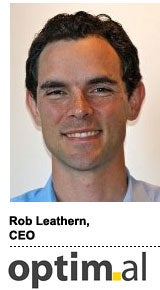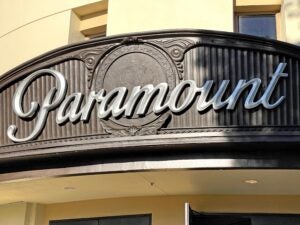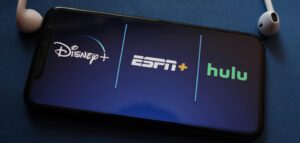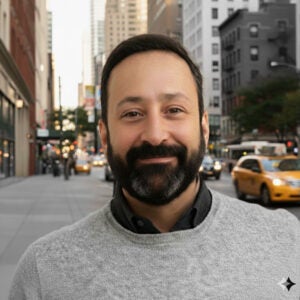 Having just closed a new $7 million round of round of funding for his social ad platform company, Optim.al CEO Rob Leathern is expecting his 30-person operation to more than double in size in the coming year. But, don’t tell Leathern that Optim.al is a Facebook ads company. He says emphatically, “We think of ourselves as a data science company. It just so happens that the biggest source of addressable audience data AND the area that’s most interesting from the data science and optimization perspective happens to be Facebook today.”
Having just closed a new $7 million round of round of funding for his social ad platform company, Optim.al CEO Rob Leathern is expecting his 30-person operation to more than double in size in the coming year. But, don’t tell Leathern that Optim.al is a Facebook ads company. He says emphatically, “We think of ourselves as a data science company. It just so happens that the biggest source of addressable audience data AND the area that’s most interesting from the data science and optimization perspective happens to be Facebook today.”
Optim.al has evolved over the years – at the start, his company focused on addressing audiences in the “traditional,” desktop display media space. Leathern claims it was hard to have scale in combination with quality audience data back then. Today, he says, it’s a different story.
AdExchanger spoke to Leathern about his company and industry trends.
AdExchanger: Six years ago it was a MySpace world, today it’s Facebook’s. What has happened with the social media ad space in that time?
ROB LEATHERN: As someone who bought and sold a lot of media in recent years, many of the questions that would arise with MySpace back-in-the-day would come up around “user generated content (UGC).” Today, I don’t think we’ve had a single customer use the term UGC, or be concerned about what content they are going to be adjacent to on Facebook.
I think people have come to this realization that they’re not going to be able to control [UGC]. They’re still obviously concerned sometimes when their ads show up next to objectionable content. But, they realize that [the negative adjacency] is just as likely to happen on a newspaper website as it is on the right-hand rail ad of Facebook.
But, it seems to be less of a concern on Facebook now because it represents a quarter or more of all ad impressions online. Facebook is also giving marketers a much more granular opportunities to target – target a man or a woman, for example -what a concept!
So, what do you plan on doing with the new funds you’ve raised? “Feet on the street” (salespeople)?
For starters, I think we did a pretty great job in building real technology while we were making money at it. We raised a reasonable amount of money – 600K in 2008 – that got us all the way to recent times. We have seen the big potential on the social media side and believe we have the best Facebook ad buying platform today. We’re eager to engage when other social media platforms are robust, too.
Regarding the funding, it felt like this was the time for us to do it. We wanted to spend more money and scale into a market that’s growing rapidly so we needed to move the ball forward.
We added a Chief Revenue Officer in August, Patrick Toland, who has experience in building sizeable business in the social media space, specifically, at TBG Digital.
AdExchanger Daily
Get our editors’ roundup delivered to your inbox every weekday.
Daily Roundup
The final thing I would say is we’ve turned down acquisition offers before — significantly sized, double-digit million, all cash offers. We believe we have a great team, set of technologies and market position and we think we can turn this into a very good company.
How does real time bidding and programmatic media intersect with what Optim.al does?
Let me give you an example. We were an early Facebook Exchange (FBX) partner where we launched the capability of inserting geo-variables – like the name of the city or time of day – into the ads in order to make them more interesting to users. There’s an aspect of “programmatic buying” to that which is about intelligence and doing stuff in real-time.
There’s an aspect of it that’s pure plumbing and making sure that you can manage hundreds of thousands of transactions a second, too. All of those things have to work together in a way in which media buyers, planners, or whomever is pulling the levers on the systems, can perform.
Another thing that people find surprising sometimes is that we’re not a services company. We do have a good services group that does manage campaigns for people but over three quarters of our revenue is self-service where people are licensing our software and using it to manage campaigns.
For anything that’s brand new like social ads, you’re going to have to provide some level of managed service for a while, but our DNA is about providing software-as-a-service.
Getting back to programmatic media, programmatic buying and selling, is that going to drive your business? Do you think of it that way?
I guess “programmatic” depends on how you define it. The two things I care about are 1) addressability and 2) automation. When those two things come together, it’s very powerful. Addressability means I have different elements that I can target and test against. I can test against people who like driving 4X4s and people who like hunting – and I can test against people who are 18 to 24 and live in Minnesota.
Whatever those different things are. I can test. There’s a lot of addressability, granularity, in what I can do. If I can only do one thing through a portal, for example, that’s not interesting and there’s not that much I can programmatically do. But, we’re in a world where the amount of data points and options that people have for buying has been expanded exponentially. No one will be effective unless they are “programmatic” around the expanding addressable options in media.
As for automation, this is the other side of that same coin which is, “It’s great that you can set up tests of four different addressable segments, but what about 4,000 segments?” How are you going to test those things? You need to have some level of automation. The next step is going to be — very soon — the automatic creation of things that didn’t exist before like ads.
But, there’s always been dynamic creative.
Yes, but dynamic creative is more like plumbing and rules. The next stage is intelligence that will create new ads that didn’t exist before – and not because you’re inserting a new variable, but because they’re trying different language structures or pulling images from different places, creating things and testing them out in a real environment.
It sounds like science fiction, but we’re not that far away from some of those things. Addressability and automation are the two keys to what I think of as “programmatic.”
What’s the most popular “use case” of how clients are working with Optim.al today?
We worked with a large company recently that on-boarded about two million opt-in email addresses into Facebook “Custom Audiences.” We pushed it through the [Facebook] API into the user match and found some subset of those two million users that we could target with ads.
We then targeted the ads to those people to get them to become fans of that brand and, no surprise, they became fans at a much higher rate than this company had ever seen before. As we continued to build the fan base, we knew what percentage of them were customers. Importantly, we were able to get their customers to a socially-connected environment where a lot things can happen.
The next stage for us was to say, “Okay, let’s show ads to the friends of all of those people.” The “friends of those fans” is something that the Facebook community offers in that you can use your friends’ implicit endorsement of a product or service to encourage others to pay attention to it. This is another efficient way to get in front of people.
The third step is where we uniquely leveraged our analytics capabilities to build look-alike audiences using that initial set of customers that we onboarded.
What’s amazing about all this is that you just have to be able to onboard your data. And at no time is this ever an individual user level analysis. This is very privacy “friendly” in that it is being done in aggregate.
What marketers fail to realize is that there’s such “low-hanging fruit” at the group level. For example, show one ad to a man, one to a woman – you don’t have to get down to a million segments to have vastly better performance. You only need to do a couple of cuts. This is one of the biggest insights that we see. Social data is disrupting the way people have bought media historically.
So is “Custom Audiences” a “game changer”?
It’s a big change. This is one of the reasons why we have been investing so heavily in Facebook. What’s going to be interesting is – does this change the game in terms of giving consumers a better advertising experience because they see more relevant ads? It can also give advertisers a much better experience, and it can increase the demand for the advertising because you’re able to be more successful – you’re getting in front of the right people. A lot of it starts with being able to create this word of mouth opportunity by starting with the customers themselves.
What channel is the hot client channel for you right now – mobile, video, desktop – and where do you see the momentum going?
Recently, we have customers who are doing much better on mobile than they had been on desktop from a cost-per-whatever perspective. We’re seeing more of our customers who are driving transactions – like retailers – on mobile devices that might have been crazy to consider a few months ago.
What milestones are you thinking about for Optim.al in the next year?
Well, we have been profitable before and we’ve decided as part of the funding that we’re not going to be profitable for now. We want to tap in on growth. We’ll be profitable again — obviously that’s the goal.
Milestones for us include having support for multiple social media platforms of scale — but a lot of that has been frankly driven more by the readiness of those platforms, like YouTube and Twitter, for companies like ours. To date for us, Facebook has been the only social media advertising game in town. I’ve told some of the players in the space that they should just do everything real-time all the time. Whether they listen to me or not, we’ll see.













